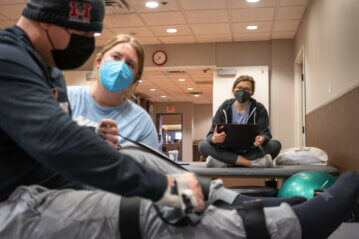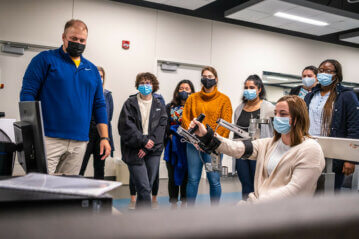Occupational therapy is often misunderstood. When you hear the term, an initial thought may be that the goal of such therapy is to help one’s job duties. While this is part of what occupational therapy involves, its full scope is much greater. This therapy is concerned with all the activities that occupy you during your daily life.
occupational therapy | therapy based on engagement in meaningful activities of daily life (such as self-care skills, education, work, or social interaction) especially to enable or encourage participation in such activities despite impairments or limitations in physical or mental functioning (Merriam-Webster)
The focus lies with what are referred to as activities of daily living (ADLs); tasks such as bed mobility, toileting, bathing, and dressing. These further extend to other in-house activities such as eating, cooking, and utilizing a computer, as well as community-based ones like driving a car. It is a therapy designed to assist in removing the barriers between you and everything you do in a day. In celebration of Occupational Therapy Month, let’s take a closer look into how this therapy can benefit individuals with neurological injuries.
Transfers and Mobility
Bed transfers are something that is dealt with on a daily level—they are ubiquitous and something that we may take for granted. For many, getting in and out of bed is a simple process, requiring a few seconds at most. However, depending on how severely they are affected, many who have suffered brain or spinal cord injuries take longer, becoming a time-intensive, calculated routine.
With a spinal cord injury that left him without the ability to walk and a limited range of motion with his
A tool that Don utilizes for these transfer practices is a half-splint he puts on both hands. Following this, two Velcro strap loops are placed around both thighs. Don then begins a slide-board transfer from the wheelchair onto the raised bed-mat that is in the Colladay Center gym. Once on the bed, Don tucks both forearms and hands underneath the thigh straps, pulling his legs up and over onto the bed. On the other end, by his feet, a larger Velcro strap with five loops sits for his arms to ease himself down into a resting position. During this time, Chapman stands by to assist the transfer and process should Don require it.
Often in the opening stages of learning new processes or transfers, a maximum level of assistance from the therapist may be expected. It takes time for any client to work a routine and process into a rhythm that is comfortable and effective. Over the weeks that Don has practiced the transfer, he has grown very adept. Chapman now only needs to step in on occasion to perform some adjustments, such as repositioning Don’s hips to center following the slide board transfer onto the bed mat.
The goal of these repetitions is to allow Don to reach a point of independence with the transfers. Through two sessions a week of this work, Don not only gets a little bit closer to that independence but also rebuilds general physical strength and endurance.
Upper Extremity Coordination and Vision Therapy
Occupational therapist Corey Cundall’s program with QLI client Thomas McKeon is a multi-faceted one, covering areas from upper extremity coordination work, to vision practice, to general independent living skills.
For one session, they are in the Gait Lab & Robotics working on the Armeo Spring. At first glance, the device looks like something out of a Sci-Fi film—a robotic arm extended out in front of a screen. The appendage-like device is strapped beneath someone’s actual arm, with the hand fitted into the end, grasping a mini-joystick.
“The Armeo allows for weight to be taken off of someone’s arm,” says Cundall. “Control is given over to the machine, and the games on the device are focused on isolating hand and wrist coordination and 
As Thomas gets into the games his head will cock slightly from one side to the other. Currently, his glasses have a large block of tape along the bridge. Due to the stroke he suffered months a few months prior, Thomas’s vision has become slightly doubled and overlapped. If focused on something with one eye, Thomas’ other eye will lag a bit behind, on a similar but not identical planar line, causing the discrepancy in his vision. In other sessions, Thomas joins Cundall in QLI’s Vision Therapy Room to angle his face and chair to look at a ball suspended from the ceiling with letters on it. He will focus one eye at a time on identifying each letter.
Following the Armeo session, their focus shifts to typing—critically important for anyone but especially for Thomas, a junior at the University of Missouri. “I want you to place your wrists on the table firmly with your hands and fingers in the air,” says Cundall. Thomas does so. “Now, bend your fingers slightly at the knuckle and place them on the table.” Cundall and Thomas practice isolating finger movements on the table, with Cundall moving one finger at a time. He notices a slight lag in Thomas’ movements. As a result of his injury, Thomas can move his right little and ring finger independently but when moving his middle finger, the index finger also moves up.
“Let’s try that again,” says Cundall. They work through it once more and after a few more repetitions, Thomas’ middle finger moves independently of his index finger. After this, they begin a typing practice. Thomas moves methodically through this, and Cundall suggests he continue the website’s exercises over the weekend.
Back to Driving
Another crucial occupational component of daily life is the ability to drive. These driving assessments typically start with a general interview between the therapist and the client seeking to drive again. What did their usual routes and commutes look like before? What was the road condition where they lived? What were the typical weather patterns like? Other questions dive into medical considerations and any trouble with speeding tickets and the like.
The purpose of these questions is to establish a baseline that will help the team to assist in getting the client back to driving if and when possible. With further assessment questions, there is a focus on any potential medical restrictions or causes for concern that might exist to inhibit the client getting back to driving. Are there any cognitive deficiencies that may negatively impact reaction time? Is the client exhibiting any vision issues that would impair their driving ability?
Following a successful assessment that affirms a client’s ability to get back to driving, the first stage of the program within the car includes an in-car assessment of the components needed for driving a car (e.g., steering wheel, gas and brake pedals, turn shift, etc.), and this is typically followed by a short lap or two around Rehabilitation Campus.
In one of the cars utilized by QLI to re-train a client’s driving ability, the steering wheel is affixed with a series of holes for the placement of hand controls, allowing for a client with a more constrained grip to instead hold onto the device and move the steering wheel through this manner. There are also right-foot and left-foot oriented pairs of pedals, very helpful for clients who have suffered strokes. Additionally, the ability exists to sync numerous car functions to a single Bluetooth device. Appearing like a larger version of the steering wheel attachment, this device has buttons along the top. One has the function of the turn signals, another of the windshield wipers, with a pad in the middle for the horn.
Certainly, when we get behind the wheel of a car, it may seem routine to us. While it’s a process that took some time to learn, it’s one in which we grew comfortable. After injury, it can take time not only to learn new adaptations like pressing the gas pedal with your left foot as opposed to you right—but also to build confidence on the road again.
…
When the assessment is complete, outside the Colladay Center, client Megan Wilson and occupational therapist Sara Waid get into a small sedan. With the start of the car and the beginning of the laps around the campus, the nervousness that Megan had demonstrated before fades. She confidently gains speed with the car, bringing it up from around five to ten miles per hour, then to a full fifteen. Initially Waid promises just one lap. As Megan’s confidence subtly rises, Waid suggests a second lap, and then a third lap.
Then, as smoothly as it began, it ends as Megan pulls the car back under the Colladay Center awning. She’ll be back out on the road again soon with Waid, starting with some smaller trips off campus before working her way towards bigger outings. For this process, it is one step at a time that makes all the difference. These guided repetitions are the crux of occupational therapy.
…
All the activities listed in the Merriam-Webster definition of occupational therapy form the core of who we are as individuals. Self-care skills allow us to function within daily routines, education and work provide our lives with clear purposes and interests, while social interaction facilitates connections with other people that may enrich our day-to-day lives. Whether it be in transferring in and out of our beds, typing on our computers, or driving our cars, occupational therapy is there to provide the programs and structure needed to help individuals get back to those pre-injury goals and crucial activities that define and guide us.
After a catastrophic injury, it is very common to hear the phrase, “I can’t do that anymore.” An occupational therapist’s response would be, “Why not?” Through retraining, compensatory strategies or adaptive technology, the therapist is able to establish a plan to remove barriers between an individual and the life they want to lead. This perspective and skill set make them an essential member of the rehabilitation team.
The American Occupational Therapy Association has additional resources and information on occupational therapy programs.
Categories: Activities of Daily Living, Occupational Therapy
